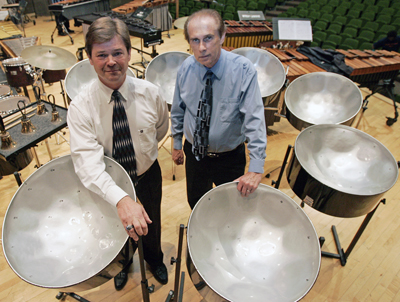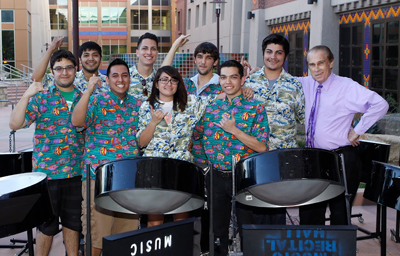By Daniel Perez
UTEP News Service
The melding of music and metallurgy at The University of Texas at El Paso started almost 20 years ago.
The beautiful Caribbean-inspired arrangements, opportunities for cutting-edge materials research and a legacy of interdisciplinary cooperation are comparable to the infusion of chocolate and peanut butter.

The product of this collaboration is UTEP’s Pandemonium – a 30-member, internationally recognized steel drum band known for its fluid, crowd-pleasing performances and its accompanying research into how the instruments acquire their pitch and tone. The related Pantastics show band performed during UTEP’s Open House in April.
Pandemonium was formed in August 1996 by Larry White, professor of music, and Lawrence Murr, Ph.D., professor of metallurgical and materials engineering. At the time, UTEP was the nation’s lone institution of higher education that combined steel drum performance and research.
Trinidad native Elliot “Ellie” Mannette was among those who fashioned the instruments from the discarded 55-gallon oil barrels left by allied forces that used Trinidad as a naval refueling station during World War II. This founder of the modern steel drum visited UTEP in the late 1990s to experience the ensemble and review the research.
Mannette promised to send Murr as many steel drums as necessary for his research, and he did. As a result, Murr and his revolving cast of 30 student-researchers spent the better part of a decade testing the drums and other materials to find the right balance to create the optimum barrel. At the same time, many of these graduate and doctoral engineering students became musicians and joined the undergraduate music majors with Pandemonium.
“I know a lot about steel drums, but I had no idea about the science involved and how it could be used to improve the instrument,” Mannette said. The science included X-rays and the importance of weights, strengths and materials to create a better steel drum. Today, manufacturers are using Murr’s processes.
“Dr. Murr’s impact on the technology has been immense,” Mannette said. “I wish I had had more time to work with him [before his retirement].” Murr will retire from UTEP in May 2014.

Murr said his interest in steel drums started after he heard the instruments during a Caribbean cruise about 30 years ago. He was intrigued by the delicate notes that the metal instrument could make and decided to incorporate it into his research. Of the 800 papers Murr has produced during a 50-year career, 24 are about steel drums – and they are among his favorites.
His research showed the crucial ingredient was the drum’s carbon content, which should be in the range of 0.06 percent to 0.08 percent.
“I had spent my life studying metals and I realized that no one had analyzed (steel drums); how they worked; how they produced their tones,” said Murr, who mostly studied explosions and ballistics for the federal government. “This is the coolest thing I’ve ever done. It was more fun than the regular stuff.”
White, director of UTEP’s percussion studies, called the steel drum one of the last frontiers of the percussion world and said he had wanted to bring the instrument to campus almost as soon as he arrived in 1980. He used a $9,000 grant to purchase the four types of drums – lead (soprano), double seconds (alto), cello (tenor) and bass. The drums, which actually are steel pans, carry from three to 32 notes.
The drums were prized possessions, so White initially rebuffed Murr’s inquiries into studying the instruments, but soon relented and the partnership turned into a friendship. White smiled as he recalled the tremendous help the program received from Murr, whose steel drum-related grants amounted to more than $250,000.
“Dr. Murr was a big part of the program,” White said. “(The ensemble) would not have reached as grand of a scale without him.”
Initially, there was little to no money to research the instruments or to pay researchers, but Murr’s zeal drew in volunteers. As a new doctoral student in 1996, Sridhar Pappu recalled being hooked by Murr’s research pitch.
“It sounded like fun, but more importantly, Dr. Murr’s enthusiasm and passion for working on this first-of-its-kind-in-the-world idea was so infectious that I could not help but be infected,” said Pappu, Ph.D., executive vice president of academics at the International School of Engineering in Hyderabad, India. He earned his master’s and doctorate from UTEP in 1996 and 2000, respectively.
Pappu enjoyed learning how to play the steel drums, performing with Pandemonium, helping others understand the science behind the drums and building camaraderie with music students. He said that his participation taught him the interconnectedness and multidisciplinary nature of seemingly unconnected aspects of life. He uses his steel drum experiences to show the inherent link between music and math to his students.
His sentiments were echoed by Elizabeth Trillo, Ph.D., another music and metallurgy peer. She recalled the excitement of being part of pioneering research into the instrument’s microstructure and the heady experience of performing before thousands of people.
“It was so much fun playing the steel drum,” said Trillo, principal engineer at Southwest Research Institute in San Antonio. “I really enjoyed it. We got to record two separate CDs with the music we learned. That was an amazing experience.”
But it’s the scientific principles she learned through her steel drum research that resonate with Trillo on a daily basis. The engineer earned her bachelor’s (1992), master’s (1994) and doctorate (1997) from UTEP.
The 2013-14 edition of Pandemonium gave its final concert of the year April 14 at the Fox Fine Arts Recital Hall. It was a bittersweet performance for Murr, who decided to retire at the end of May after 50 years in academia, with the last 25 at UTEP. He said he plans to stay busy finishing his legacy book, presenting at the Pan American Materials Conference in July in Brazil and serving as a visiting distinguished professor at three Chinese institutions.
One thing is for certain: he will not blend into the background.
“You need a purpose in life. You have to set goals. I’ve been passionate about science since I was a kid,” he said, adding that his basement lab in Lititz, Penn., was better equipped than the one in his high school. “Now people pay me to do what I love. That’s the cool thing. I still want to be involved in research, but now I want to see what I do when I grow up.”